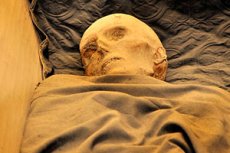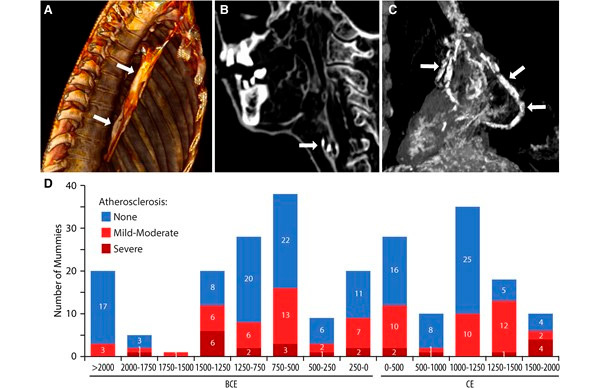
People usually think of heart disease as a byproduct of modern fast-food living, but new research shows the condition has been plaguing humanity for centuries. The study results were published in the European Heart Journal.
CT scans revealed that more than a third (37%) of 237 adult mummies from seven different cultures spanning more than 4,000 years had signs of clogged arteries.
Researchers say the results show people have an inherent risk of atherosclerosis, a buildup of plaque in the arteries that can lead to heart attack and stroke.
"We found atherosclerosis across all time periods - going back to 2500 BC - in men and women, in all seven cultures that were studied, among both elite and non-elite," said lead researcher Dr. Randall Thompson, a cardiologist at St. Luke's Heart Institute in Kansas City, Missouri. "This further confirms our previous observation that this is not just a modern condition caused by our modern lifestyle."
(A) CT volumetric reconstruction demonstrating extensive atherosclerosis (arrows) in the aorta of a female mummy from ancient Peru (Rosita). (B) Multiplanar reconstruction: Sagittal CT view demonstrates severe calcification in the left carotid bulb (arrow). (C) Thick-layer maximum intensity projection: a modified coronal computed tomography image demonstrates severe calcium deposition in the coronary arteries in a female Egyptian mummy from the late Middle Kingdom–Second Intermediate Period. (D) Number of mummies with no, mild or moderate (one to two vascular regions affected) and severe (three to five vascular areas affected) atherosclerotic calcification for each of the 13 eras. Atherosclerotic calcifications have been observed in mummies from all eras. BCE, BC; CE, Common Era.
Researchers said the mummies came from different parts of the world, including ancient Egyptians, ancient Peruvians from the lowlands, ancient Andean Bolivians from the highlands, 19th-century Aleutian hunter-gatherers, 16th-century Greenlandic Inuit, Ancestral Puebloans and desert herders Gobi of the Middle Ages.
Most of the cases corresponded to early stages of heart disease, which are often detected on CT scans of modern patients, the researchers said.
"This study shows that modern risk factors for cardiovascular disease, such as smoking, a sedentary lifestyle and poor diet, when superimposed on the inherent risk inherent in the aging process, may increase the extent and impact of atherosclerosis," Thompson said in St. Luke's press release. "That's why it's especially important to control the risk factors that we can control."

